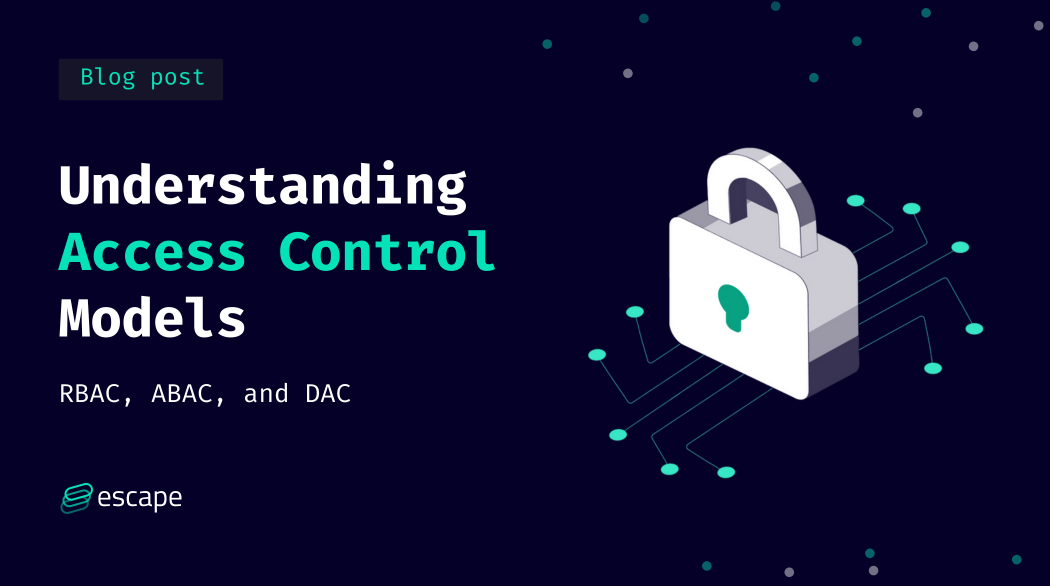Understanding Access Control Models: RBAC, ABAC, and DAC
Different models of access control offer unique methods and benefits. The three primary models are Role-Based Access Control (RBAC), Attribute-Based Access Control (ABAC), and Discretionary Access Control (DAC).

Access control is a fundamental aspect of information security, ensuring that only authorized users can access specific resources in a system. Different models of access control offer unique methods and benefits, catering to various organizational needs. The three primary models are Role-Based Access Control (RBAC), Attribute-Based Access Control (ABAC), and Discretionary Access Control (DAC). Each model has its distinctive features, advantages, and ideal use cases.
Role-Based Access Control (RBAC)
Role-Based Access Control (RBAC) is one of the most widely used access control models. In RBAC, permissions are assigned to roles, and users are then assigned to these roles. This model simplifies management by grouping permissions into roles rather than assigning permissions directly to users.
1. Roles: Defined based on job functions within an organization.
2. Permissions: Assigned to roles, not directly to users.
3. User-Role Assignment: Users are granted roles that provide them with the necessary permissions.
Benefits of RBAC:
- Simplified Management: Easier to manage permissions by handling roles instead of individual users.
- Scalability: Suitable for large organizations where roles can be reused across different users.
- Least Privilege Enforcement: Ensures users have only the necessary access to perform their job functions.
- Audit and Compliance: Simplifies auditing and compliance processes by providing clear mappings between roles and permissions.
Use Cases for RBAC:
- Large Enterprises: Where predefined roles can be easily assigned to numerous employees.
- Regulated Industries: Such as healthcare and finance, where compliance and auditing are critical.
Attribute-Based Access Control (ABAC)
Attribute-Based Access Control (ABAC) is a more dynamic and flexible model. It makes access decisions based on attributes associated with users, resources, and the environment. These attributes can include user roles, department, time of access, and more.
1. Attributes: Define characteristics of users, resources, and environmental conditions.
2. Policies: Set rules that evaluate attributes to grant or deny access.
3. Dynamic Access Decisions: Access is determined in real-time based on current attributes.
Benefits of ABAC:
- Flexibility: Can handle complex access control scenarios and dynamically adapt to changes.
- Granularity: Allows fine-grained access control by considering multiple attributes.
- Context-Aware: Can make access decisions based on real-time contextual information.
Use Cases for ABAC:
- Dynamic Environments: Where access decisions need to adapt to changing conditions, such as in cloud computing.
- Highly Regulated Data: Requiring fine-grained control, like in government and defense sectors.
- Collaborative Environments: Where users from different organizations need varying levels of access.
Discretionary Access Control (DAC)
Discretionary Access Control (DAC), a more advanced type of access control, grants access based on the discretion of the resource owner. In DAC, the owner of a resource decides who can access it and what kind of access they can have.
1. Resource Ownership: Users can create resources and control access to them.
2. Access Control Lists (ACLs): Lists specifying which users or groups have access to a resource and the type of access allowed.
3. User Discretion: Owners have complete control over their resources.
Benefits of DAC:
- Flexibility: Resource owners can make quick and specific access decisions.
- User Empowerment: Empowers users to control their own data.
- Simplicity: Easy to understand and implement in small environments.
Use Cases for DAC:
- Small Organizations: Where the number of users and resources is manageable.
- Personal Data: Where users need to control access to their own files.
- Ad-hoc Projects: With temporary teams needing flexible access control.
Choosing the Right Model
Selecting the appropriate access control model depends on various factors, including organizational size, regulatory requirements, and the complexity of the access control needs.
- RBAC is ideal for large organizations with well-defined roles and responsibilities.
- ABAC suits dynamic and complex environments requiring fine-grained, context-aware access decisions.
- DAC works best in smaller, less structured settings where resource owners need control over their data.
Conclusion
Understanding the differences and benefits of RBAC, ABAC, and DAC helps organizations implement effective access control measures tailored to their specific needs. Each model offers unique strengths, from RBAC's simplified role management to ABAC's dynamic flexibility and DAC's user empowerment. By carefully evaluating their access control requirements, organizations can choose the model that best enhances their security posture while ensuring efficient and compliant access to resources. To ensure the best possible security for your application, make sure to follow our API Checklist.
